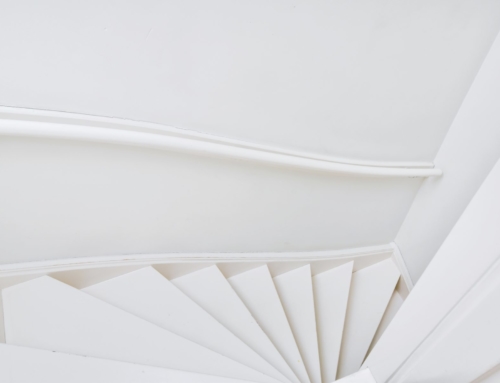Whether you’re designing a closed or open riser staircase, the planning stages of your project are critical to its success. As well as creating a design that suits your home and works well for all the family, you’ll need to consider which rules and legislation apply to new staircase builds. This includes building regulations for stairs.
Here’s our breakdown of the key points to know.

What are building regulations for staircases?
You may have heard of planning permission for replacing stairs, but what about building regulations? While planning applications relate to the development and use of land, building regulations ensure health and safety criteria are met, specifying the minimum standards for building design elements.
Staircases can be safety hazards if their design isn’t carefully considered. Hence, building regulations cover a multitude of areas, including preventing falls and limiting how steep the stairs are built.
What staircase rules should you know about?
The main piece of legislation to consider when designing a new staircase is Approved Document K. These regulations outline steps for protection from falling, collision and impact in a property, especially when moving between different floors of a home.
Some of the rules for the main staircase in a dwelling include:
- Staircases need a maximum rise and minimum going (tread depth) of 220mm.
- The maximum pitch of a private staircase should be 42 degrees with a minimum of 2m clear headroom.
- They shouldn’t allow the passage of a 100mm diameter sphere at any opening (including balustrades and open riser staircases).
- The top of handrails should be fixed at least 900mm to 1m higher than the pitch line or floor (even if part of the guarding).
- Handrails should be fixed on both sides of the staircase if it exceeds a width of 1m.
- Open riser treads should overlap at least 16mm.
As with many planning laws and building regulations, there are always exceptions to the rules based on the type of staircase installed, so it’s best to familiarise yourself with Approved Document K when going into this type of project.
How to ensure your staircase meets the right criteria
So, how can you ensure your project meets all the necessary criteria? The easiest way is to get a specialist staircase company on board early in the process.
They’ll have extensive knowledge about the different design elements involved and how to
meet the relevant building regulations. This achieves a smoother process, and you’ll have peace of mind that your new stairs put health and safety first.
A staircase company will work closely with you to create a design that helps your property flow, lets in lots of natural sunlight and makes life easier for all the family. You can also explore the different ways to use the space and maximise its potential.
Request a staircase consultation now
For more advice, speak to our staircase experts at DDC London. We work across London, Surrey and surrounding areas, including Bicester and Hillingdon. To get in touch, please call 020 8004 9635 or email sales@ddclondon.co.uk.
